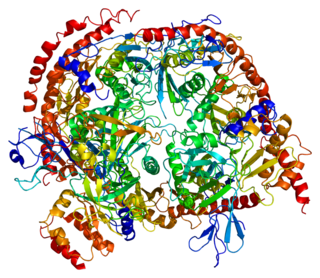
The exosome complex is a multi-protein intracellular complex capable of degrading various types of RNA molecules. Exosome complexes are found in both eukaryotic cells and archaea, while in bacteria a simpler complex called the degradosome carries out similar functions.

Polynucleotide Phosphorylase (PNPase) is a bifunctional enzyme with a phosphorolytic 3' to 5' exoribonuclease activity and a 3'-terminal oligonucleotide polymerase activity. That is, it dismantles the RNA chain starting at the 3' end and working toward the 5' end. It also synthesizes long, highly heteropolymeric tails in vivo. It accounts for all of the observed residual polyadenylation in strains of Escherichia coli missing the normal polyadenylation enzyme. Discovered by Marianne Grunberg-Manago working in Severo Ochoa's lab in 1955, the RNA-polymerization activity of PNPase was initially believed to be responsible for DNA-dependent synthesis of messenger RNA, a notion that was disproven by the late 1950s.

Exosome component 2, also known as EXOSC2, is a protein which in humans is encoded by the EXOSC2 gene.

Exosome component 10, also known as EXOSC10, is a human gene, the protein product of which is part of the exosome complex and is an autoantigen is patients with certain auto immune diseases, most notably scleromyositis.

Exosome complex exonuclease RRP44 or Dis3 is an enzyme that in humans is encoded by the DIS3 gene. Its protein product is an RNase enzyme homologous to the yeast protein Rrp44, and can be part of the exosome complex in the nucleus of eukaryotic cells.

Ribonuclease P protein subunit p20 is an enzyme that in humans is encoded by the POP7 gene.

Ribonucleases P/MRP protein subunit POP1 is a protein that in humans is encoded by the POP1 gene.

Exosome component 8, also known as EXOSC8, is a human gene, the protein product of which is part of the exosome complex.

Exosome component 7, also known as EXOSC7, is a human gene, the protein product of which is part of the exosome complex.

Exosome component 3, also known as EXOSC3, is a human gene, which is part of the exosome complex.

Ribonuclease P/MRP protein subunit POP5 is an enzyme that in humans is encoded by the POP5 gene.

Exosome component 9, also known as EXOSC9, is a human gene, the protein product of which is part of the exosome complex and is an autoantigen is patients with certain auto immune diseases, most notably scleromyositis.

Exosome component 4, also known as EXOSC4, is a human gene, which is part of the exosome complex.

Superkiller viralicidic activity 2-like 2 is a protein that in humans is encoded by the SKIV2L2 gene.

Exosome component 5, also known as EXOSC5, is a human gene, which is part of the exosome complex.

Ribonuclease P protein subunit p38 is an enzyme that in humans is encoded by the RPP38 gene.

Ribonuclease P protein subunit p14 is an enzyme that in humans is encoded by the RPP14 gene.

Nuclear nucleic acid-binding protein C1D is a protein that in humans is encoded by the C1D gene. The C1D protein is encoded by a DNA binding gene traced in the nucleus. Protein C1D has a chromosomal location of 2p14. C1D has a family of proteins consisting of C1D homologues which may include Sas10 domains. C1D is thought to bind to RNA and DNA where it may be involved in mechanisms of DNA repair. Protein C1D is ubiquitously expressed in different human tissues.

U3 small nucleolar RNA-interacting protein 2 is a protein that in humans is encoded by the RRP9 gene.

Exosome complex exonuclease MTR3 is an enzyme that in humans is encoded by the EXOSC6 gene.
























